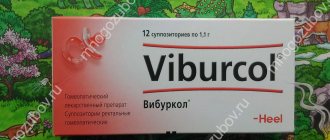Suppository forms of drug release are becoming increasingly common in medical practice in all countries of the world. Suppositories (candles) ensure rapid delivery of active substances into the systemic circulation, and they are compact and easy to use. It is especially convenient to use suppositories during ARVI, when the child has a high temperature, he is capricious and does not want to take any pills or syrups.
- Instructions for use for children
- with ARVI
- for infectious and inflammatory diseases
- for chronic viral hepatitis
- Side effects
- Contraindications
- Drug interactions
- Advantages
- How to light a candle for a child
What are suppositories made of
? Suppositories (from the Latin Suppositorius - substitute, comes from Supponere - to put) are dosage forms that are solid at room temperature and dissolve at body temperature. According to historical documents, suppositories (candles) have been used throughout the world and in Rus' since ancient times. When humanity was just learning to create medicines. Ancient healers made rectal and vaginal suppositories. Herbal books, medical books and handwritten pharmacopoeias indicate that suppositories were made from soap, lard, honey or plant juice.
Over time, the composition of the suppositories changed, pharmacists tried new recipes and as a result came to the conclusion that to facilitate the use of rectal suppositories, which is especially important when treating children, it is necessary to add oil to the suppositories. And these days, the classic base for suppositories is also cocoa butter. It is a vegetable fat of dense consistency, obtained by pressing the seeds of the chocolate tree, which grows in the tropics. Such suppositories are easily inserted into the rectum and do not cause any discomfort even in the smallest children. It is important that cocoa butter, unlike cocoa powder, does not contain plant allergens, so it can be used in the treatment of patients with allergies.
It is important for children that medications in this form do not need to be swallowed, since not all children like the taste of syrups and not everyone, due to their age, can swallow a tablet. While the use of suppositories allows the child to administer the medicine in full. In addition, suppositories do not overload the gastrointestinal tract.
As is known, medicinal substances belonging to almost all pharmacological groups are well absorbed in the rectum. The rate of absorption is not inferior to that of intramuscular administration of drugs1. Medicinal substances are absorbed through the mucous membrane of the rectum, enter the hemorrhoidal veins, then into the inferior vena cava, and then into the general blood flow of the systemic circulation, bypassing the protective barrier of the liver.
Instructions for use Viferon suppositories 150,000 IU for children
The drug VIFERON Suppositories (suppositories), which are based on cocoa butter, is an immunomodulatory drug with an antiviral effect. It is produced in the form of rectal suppositories, bullet-shaped, white-yellow or yellow in color. 1 suppository contains human recombinant interferon alpha-2b as an active substance in dosages of 150,000 IU, 500,000 IU, 1,000,000 IU and 3,000,000 IU. The weight of the suppository is no more than 1 gram.
The drug suppresses the activity of viruses and increases the effectiveness of the body's own immune response to pathogenic microorganisms. Cocoa butter contains phospholipids, which make it possible not to use synthetic toxic emulsifiers in production, and the presence of polyunsaturated fatty acids facilitates the administration and dissolution of the drug.
The drug VIFERON Candles (suppositories) can be used even during pregnancy (at a dosage of 500,000 IU from the 14th week), during breastfeeding and in the treatment of newborns.
For ARVI in children
In case of influenza, adenovirus, rhinovirus and other acute respiratory viral infections, including those complicated by bacterial infection and pneumonia, children under 7 years of age, incl. newborns and premature infants with a gestational age of more than 34 weeks are prescribed an antiviral drug at a dosage of 150,000 IU, 1 suppository 2 times a day after 12 hours every day for five days. According to clinical indications, therapy can be continued. The break between courses is five days.
Gestational age is the age of the embryo and fetus from the moment of fertilization, which corresponds to the gestational age.
For infectious and inflammatory diseases of newborns
For meningitis, sepsis and intrauterine infections in newborns, including premature infants with a gestational age of more than 34 weeks, it is recommended to use the drug 150,000 IU daily, 1 suppository 2 times a day every 12 hours. The course of treatment is five days.
Premature newborns with a gestational age of less than 34 weeks are prescribed the drug VIFERON Suppositories 150,000 IU daily, 1 suppository 3 times a day after 8 hours. The course of treatment is also five days.
When treating meningitis in a child, it is recommended to undergo one or two courses of treatment with the antiviral drug VIFERON, for such a dangerous disease as sepsis - two or three courses, for enterovirus infection - one or two courses, for cytomegalovirus infection - two or three courses. If a child is diagnosed with mycoplasmosis, candidiasis, including visceral candidiasis, two or three courses of treatment with an antiviral drug are indicated. During the course of treatment it is necessary to take breaks - five days. Treatment can be continued according to clinical indications and pediatrician recommendations.
For chronic viral hepatitis B, C, D in children
For children aged 1 to 7 years, 3,000,000 IU per 1 m2 of body surface area per day is recommended. For children over 7 years old, 5,000,000 IU per 1 m2 of body surface area per day is recommended.
The drug is used 2 times a day every 12 hours for the first 10 days, then three times a week every other day for 6-12 months. The duration of treatment is determined by clinical effectiveness and laboratory parameters.
The daily dose of the drug for each patient is calculated by multiplying the recommended dose for a given age by the body surface area calculated using the nomogram for calculating body surface area by height and weight according to Garford, Terry and Rourke. The calculation of a single dose is carried out by dividing the calculated daily dose into 2 administrations, the resulting value is rounded up to the dosage of the suppository.
In case of chronic viral hepatitis of pronounced activity and liver cirrhosis, before plasmapheresis and/or hemosorption, it is recommended to use VIFERON® 150,000 IU for children under 7 years of age, VIFERON® 500,000 IU for children over 7 years of age, 1 suppository 2 times a day after 12 h daily for 14 days.
How and when teething occurs in children
First, let's look at the cutting process itself. It is worth noting that this happens differently for each child. But, nevertheless, there is a certain pattern in this process, by which pediatricians can recognize normality or pathology. Let us dwell on this issue in more detail.
Scheme of baby teeth eruption
Parents often ask this question: “What time do children start teething?”
Baby teeth are the first to erupt in children. They cut through in the following sequence:
- At the age of six to seven months, the eruption of the lower incisors begins.
- Starting from the eighth to ninth month, the upper incisors begin to erupt.
- From the age of ten months, the upper lateral incisors erupt.
- At 1 year of age, two lower lateral incisors appear.
- Between 12 and 15 months, the first molars appear.
- Fangs appear at the age of 17-20 months.
- Second molars appear between 20 and 24 months.
It is worth noting that teeth of the same name erupt simultaneously on each half of the jaw. As a rule, the lower ones tend to erupt before the upper ones.
There is also a formula by which you can quickly calculate the approximate number of milk teeth required. According to this formula, it is necessary to subtract the number 4 from the child’s age in months. This formula is often used by pediatricians, which makes it possible to identify discrepancies in the timing of teething. The most common reason for the delay in this process is the development of rickets . Rickets is a disease of young children associated with a lack of vitamin D, which affects the condition of the entire body, primarily the musculoskeletal system (reduced muscle tone, softening of bones, bone deformation).
According to a certain pattern, the formation of a child’s primary bite occurs. The bite is the relationship between the teeth of the upper and lower jaw. The final formation of the primary occlusion occurs by 2.5 years. The deciduous dentition plays a large role in the development of speech and the ability to chew food. Then, as the baby grows, there is a change from dairy to permanent.
Scheme of eruption of permanent teeth
The time interval between the loss of a baby tooth and the appearance of a permanent tooth is four months. At the age of five years, the first permanent teeth appear—the first molars. There is also a formula for the eruption of permanent teeth. According to this formula, in order to calculate the number of constants, you need to multiply 4 by the child’s age in years and subtract 20.
After the first permanent teeth appear, a mixed bite is formed.
Symptoms often appear during the eruption of baby teeth and, as a rule, in children in the first year of life . We must not forget that after the baby’s teeth appear, they need to be properly cared for. You can find out more about this issue in our article.
After your baby's teeth appear, they need to be properly cared for.
Benefits of suppositories
Among the main advantages of candles:
- entry of medicinal substances directly into the general circulation;
- no dependence between the use of suppositories and food intake;
- high rate of absorption of drugs;
- independence of the absorption effect from the filling of the digestive tract;
- easy introduction of substances that have unpleasant organoleptic properties - it is usually difficult to persuade a child to take a tablet or syrup, which can be bitter and tasteless;
- simplicity and painlessness of drug administration;
- the possibility of combining ingredients with various pharmacological and physicochemical properties in suppositories;
- the absence of dyes and sweeteners minimizes the possibility of allergies;
- compactness of the dosage form;
- rectal administration does not require special instruments and is carried out without disturbing the skin.
How to administer the children's suppository VIFERON 150,000 IU to a child?
If your child has already grown up, before introducing the suppository, explain to him that this is necessary for his recovery and will not cause any discomfort. It is best to distract a younger child during the procedure by inviting someone close to you to help. Or you can try to play a fun game with your child, which is that a candle is a rocket, a submarine or a magic fish that will get rid of illness, bring health and good mood.
Before administration, remove it from the packaging. Lay the child on his left side, while keeping his lower leg straight and his upper leg tucked toward his stomach. In children under one year of age, the suppository can also be administered in the supine position with the legs brought to the tummy (as when changing a diaper). Gently spread the child's buttocks, then gently and confidently insert the candle into the anus with the pointed end first. After this, you need to lightly squeeze the child’s buttocks and hold them squeezed for two to three minutes.
Reference and information material
Author of the article
Belyaev Dmitry Alexandrovich
General doctor
- Pieter van der Bijl, Armorel Diane van Eyk, Permeability of human intestinal mucosa using a continuous flow-through perfusion system // International Journal of Pharmaceutics 235(1-2):71-8 · March 2002.
Loading...
Take other surveys
Viferon for teething
I found it on the Internet, I’ll leave it here, it’ll come in handy.
First aid kit for babies









